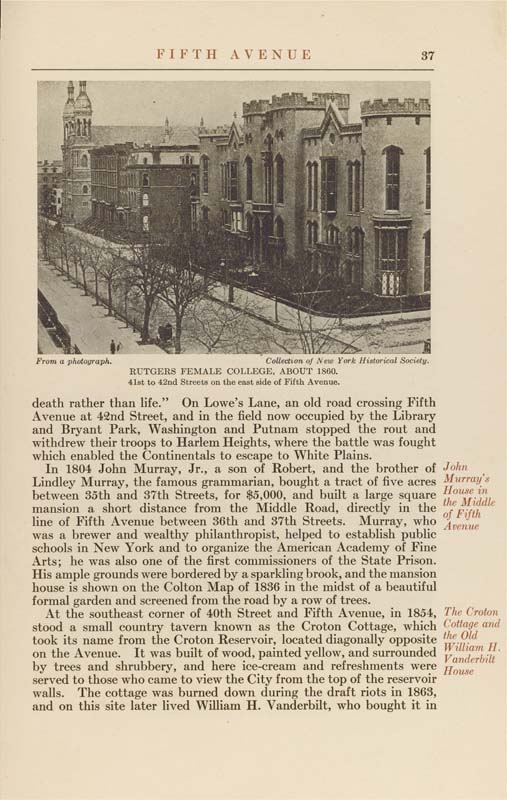FIFTH AVENUE
37
From a photograph.
Collection oj JS/ew York Historical Society.
RUTGERS FEMALE COLLEGE, ABOUT 1860.
41st to 42nd Streets on the east side of Fifth Avenue.
death rather than life." On Lowe's Lane, an old road crossing Fifth
Avenue at 42nd Street, and in the field now occupied by the Library
and Bryant Park, Washington and Putnam stopped the rout and
withdrew their troops to Harlem Heights, where the battle was fought
which enabled the Continentals to escape to White Plains.
In 1804 John Murray, Jr., a son of Robert, and the brother of
Lindley Murray, the famous grammarian, bought a tract of five acres
between 35th and 37th Streets, for $5,000, and built a large square
mansion a short distance from the Middle Road, directly in the
line of Fifth Avenue between 36th and 37th Streets. Murray, who
was a brewer and wealthy philanthropist, helped to establish public
schools in New York and to organize the American Academy of Fine
Arts; he was also one of the first commissioners of the State Prison.
His ample grounds were bordered by a sparkling brook, and the mansion
house is shown on the Colton Map of 1836 in the midst of a beautiful
formal garden and screened from the road by a row of trees.
At the southeast corner of 40th Street and Fifth Avenue, in 1854,
stood a small country tavern known as the Croton Cottage, which
took its name from the Croton Reservoir, located diagonally opposite
on the Avenue. It was built of wood, painted yellow, and surrounded
by trees and shrubbery, and here ice-cream and refreshments were
served to those who came to view the City from the top of the reservoir
walls. The cottage was burned down during the draft riots in 1863,
and on this site later lived William H. Vanderbilt, who bought it in
John
Murray's
House in
the Middle
of Fifth
Avenue
The Croton
Cottage and
the Old
William H.
Vanderbilt
House
|








